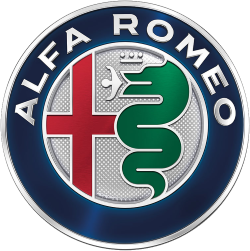
Alfa Romeo Automobiles S.p.A. is an Italian luxury carmaker known for its sports-oriented vehicles, strong auto racing heritage, and iconic design. Headquartered in Turin, Italy, it is a subsidiary of Stellantis Europe and one of 14 brands of multinational automotive company Stellantis.
Innocenti was an Italian machinery works, originally established by Ferdinando Innocenti in 1933 in Lambrate, a neighborhood on the eastern outskirts of Milan. Over the years, they produced Lambretta scooters as well as a range of automobiles, mainly of British Leyland origins. The brand was retired in 1996, six years after being acquired by Fiat.

The Fiat Tempra is a small family car produced by the Italian automaker Fiat from 1990 to 1996 in Italy. The Tempra was intended as a replacement for the Fiat Regata. The original project was called Tipo 3, being a mid-size car between the Fiat Tipo and the bigger Fiat Croma. The Tempra shares its Type Three platform with the Lancia Dedra and Alfa Romeo 155.

The Alfa Romeo 33 is a small family car produced by the Italian automaker Alfa Romeo between 1983 and 1995. From a mechanical standpoint it was essentially an evolution of its predecessor, the Alfasud, whose floorpan, chassis and drivetrain were carried over — albeit with simplifications to the suspension and braking system, eschewing the Alfasud's inboard front brakes for instance. The Nissan-based Alfa Romeo Arna was launched shortly thereafter, offering a similarly sized but lower priced car.
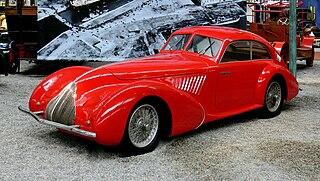
The Alfa Romeo 8C was a range of Alfa Romeo road, race and sports cars of the 1930s.

The Alfa Romeo Boxer engine was a water-cooled flat-4 piston engine, developed by Alfa Romeo for front-wheel drive, and longitudinal applications. It debuted on the Alfasud, which was introduced in 1971 at the Turin Motor Show. In the following decades the Boxer went through several upgrades and powered many Alfa Romeo front-wheel drive cars up to 1996. In 1997 it was phased out and replaced by the transversely-mounted Twin Spark engines.

The Alfa Romeo 2000 is a luxury car produced by Italian car manufacturer Alfa Romeo between 1958 and 1962, as a successor to the 1900 Super. It was replaced in 1962 by the Alfa Romeo 2600.
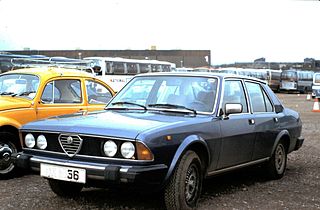
The Alfa Romeo Alfa 6 is an executive car produced by the Italian automaker Alfa Romeo from 1979 to 1986. Its name refers to the six cylinders of the Alfa Romeo V6 engine, which made its first appearance on this car.

The Alfa Romeo 90 is an executive car produced by Italian car manufacturer Alfa Romeo between 1984 and 1987.

The Alfa Romeo GTA is a coupé automobile manufactured by the Italian manufacturer Alfa Romeo from 1965 to 1971. It was made for racing (Corsa) and road use (Stradale).

The Alfa Romeo Alfetta is a front-engine, five-passenger sedan and fastback coupé manufactured and marketed by Alfa Romeo from 1972 to 1987 with a production total over 400,000.

The Alfa Romeo Twin Cam engine is an all-alloy inline-four engine series produced by Alfa Romeo from 1954 to 1994. In Italian it is known as the "bialbero" ("twin-shaft"), and has also been nicknamed the "Nord" (North) engine in reference to its being built in Portello, Milan, in the North of Italy and to distinguish it from the Alfa Romeo Boxer engine built in the South (Sud) for the Alfasud.

The Alfa Romeo 1750 Berlina and Alfa Romeo 2000 Berlina were executive cars produced by Italian car manufacturer Alfa Romeo from 1968 to 1977. Berlina is the Italian term for a saloon car. Both cars had Alfa Romeo twin cam inline-four engines; the 1.8-litre 1750 Berlina was made between 1968 and 1971, when it was phased out in favour of the improved 2.0-litre 2000 Berlina.

The Alfa Romeo V6 engine is a 60° V6 engine made by Alfa Romeo from 1979 to 2005. It was developed in the early 1970s by Giuseppe Busso, and first used on the Alfa 6 with a displacement of 2.5 L (2,492 cc) and a SOHC 12-valve cylinder head. Later versions ranged from 1,996 to 3,179 cc and had DOHC 24-valve valvetrains. The original design had short pushrods for the exhaust valves in a design similar to earlier Lancia Fulvia engines. The first DOHC version was in the 1993 Alfa Romeo 164, with an aluminium alloy engine block and head with sodium filled exhaust valves.
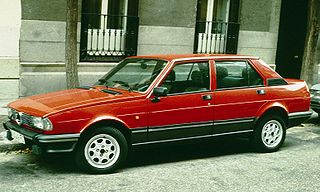
The Alfa Romeo Giulietta is a small executive saloon car manufactured by Italian car maker Alfa Romeo from 1977 to 1985. The car was introduced in November 1977 and while it took its name from the original Giulietta of 1954 to 1965, it was a new design based on the Alfa Romeo Alfetta chassis. The Giulietta went through two facelifts, the first in 1981 and the second one in 1983. All Giuliettas used 5-speed manual transmissions.

The Alfa Romeo 158/159, also known as the Alfetta, is a Grand Prix racing car produced by Italian manufacturer Alfa Romeo. It is one of the most successful racing cars ever; the 158 and its derivative, the 159, took 47 wins from 54 Grands Prix entered. It was originally developed for the pre-World War II voiturette formula (1937) and has a 1.5-litre straight-8 supercharged engine. Following World War II, the car was eligible for the new Formula One introduced in 1947. In the hands of drivers such as Nino Farina, Juan Manuel Fangio and Luigi Fagioli, it dominated the first two seasons of the World Championship of Drivers.
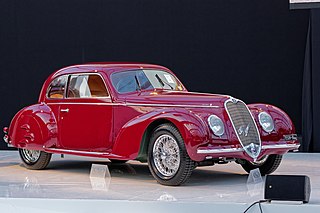
The Alfa Romeo 6C name was used on road, race, and sports cars produced between 1927 and 1954 by Alfa Romeo; the "6C" name refers to the six cylinders of the car's straight-six engine. Bodies for these cars were made by coachbuilders such as James Young, Zagato, Touring Superleggera, Castagna, and Pinin Farina. Beginning in 1933 there was also a 6C version with an Alfa factory body, built in Portello. In the early 1920s Vittorio Jano received a commission to create a lightweight, high performance vehicle to replace the Giuseppe Merosi designed RL and RM models. The car was introduced in April 1925 at the Salone dell' Automobile di Milano as the 6C 1500. It was based on Alfa's P2 Grand Prix car, using a single overhead cam 1,487 cc in-line six-cylinder engine, producing 44 horsepower. In 1928 the 1500 Sport was presented, which was the first Alfa Romeo road car with double overhead camshafts.

Fábrica Nacional de Motores (FNM) was a Brazilian manufacturer of engines and motor vehicles based in the Xerém district of Duque de Caxias near Rio de Janeiro that operated between 1942 and 1988. In 2018, the manufacturer was refounded, changing its name to Fábrica Nacional de Mobilidades based in Rio de Janeiro and producing electric trucks at the Agrale factory in Rio Grande do Sul.
The Alfa Romeo Mille is an eight-ton forward control lorry produced by Alfa Romeo between 1958 and 1964. It was the last Alfa Romeo heavy commercial vehicle.


















